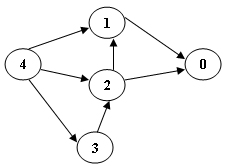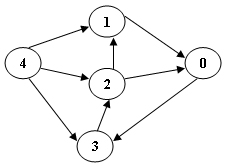6-16 Topological Sort(25 point(s))
来源:互联网 发布:淘宝退货折旧费怎么算 编辑:程序博客网 时间:2024/06/05 23:03
6-16 Topological Sort(25 point(s))
Write a program to find the topological order in a digraph.
Format of functions:
bool TopSort( LGraph Graph, Vertex TopOrder[] );where LGraph is defined as the following:
typedef struct AdjVNode *PtrToAdjVNode; struct AdjVNode{ Vertex AdjV; PtrToAdjVNode Next;};typedef struct Vnode{ PtrToAdjVNode FirstEdge;} AdjList[MaxVertexNum];typedef struct GNode *PtrToGNode;struct GNode{ int Nv; int Ne; AdjList G;};typedef PtrToGNode LGraph;The topological order is supposed to be stored in TopOrder[] whereTopOrder[i] is the i-th vertex in the resulting sequence. The topological sort cannot be successful if there is a cycle in the graph -- in that caseTopSort must return false; otherwise return true.
Notice that the topological order might not be unique, but the judge's input guarantees the uniqueness of the result.
Sample program of judge:
#include <stdio.h>#include <stdlib.h>typedef enum {false, true} bool;#define MaxVertexNum 10 /* maximum number of vertices */typedef int Vertex; /* vertices are numbered from 0 to MaxVertexNum-1 */typedef struct AdjVNode *PtrToAdjVNode; struct AdjVNode{ Vertex AdjV; PtrToAdjVNode Next;};typedef struct Vnode{ PtrToAdjVNode FirstEdge;} AdjList[MaxVertexNum];typedef struct GNode *PtrToGNode;struct GNode{ int Nv; int Ne; AdjList G;};typedef PtrToGNode LGraph;LGraph ReadG(); /* details omitted */bool TopSort( LGraph Graph, Vertex TopOrder[] );int main(){ int i; Vertex TopOrder[MaxVertexNum]; LGraph G = ReadG(); if ( TopSort(G, TopOrder)==true ) for ( i=0; i<G->Nv; i++ ) printf("%d ", TopOrder[i]); else printf("ERROR"); printf("\n"); return 0;}/* Your function will be put here */Sample Input 1 (for the graph shown in the figure):
5 71 04 32 12 03 24 14 2Sample Output 1:
4 3 2 1 0Sample Input 2 (for the graph shown in the figure):
5 80 31 04 32 12 03 24 14 2Sample Output 2:
ERROR拓扑排序问题,具体讲解可以看点击打开链接 ,感觉讲的很清楚代码:bool TopSort( LGraph Graph, Vertex TopOrder[] ){int indegree[MaxVertexNum];//用于保存每个点的入度 int q[MaxVertexNum];//队列,用于优化时间复杂度,每次找零度的点只需要从上次零度点相邻的里面找int i;int num = 0;//记录拓扑排序数组下标 int head=0,tail=0;PtrToAdjVNode t;for(i = 0; i < Graph->Nv; i++){indegree[i] = 0;}for(i = 0; i < Graph->Nv; i++){//遍历每一个点 t = Graph->G[i].FirstEdge; while(t){//遍历每一个点后面所连的点 indegree[t->AdjV]++;t = t->Next;}}//对入度进行初始化 for(i = 0; i < Graph->Nv; i++){if(indegree[i]==0){q[tail++] = i;//先找到入度为零的点,加入队列,然后对队列进行操作即可 }}if(head==tail)return false;//如果找了一圈没有入度为零的点,肯定不对,返回false//队列操作while(head<tail){t = Graph->G[q[head]].FirstEdge;//取出队首的元素while(t){//对队首元素相邻的点进行遍历,操作 if(indegree[t->AdjV]<0)return false;//如果这个点入度为负数,说明之前肯定已经放在拓扑排序数组里了,再出现说明有环 indegree[t->AdjV]--;//相邻元素入度减一 if(indegree[t->AdjV]==0){q[tail++] = t->AdjV;//减后为零入队 }t = t->Next;} indegree[q[head]] = -1;//表示这个点不能再出现了 TopOrder[num++] = q[head++]; }if(num!=Graph->Nv)return false;else return true; }
阅读全文
0 0
- 6-16 Topological Sort(25 point(s))
- Topological Sort(25 分)
- 拓扑排序(Topological Sort)
- 拓扑排序(Topological Sort)
- 拓扑排序(topological-sort)
- 拓扑排序(topological sort)
- 拓扑排序(topological sort)
- 拓扑排序(Topological Sort)
- topological-sort(拓扑排序)
- topological-sort
- Topological Sort
- Topological Sort
- Topological Sort
- 6-7 Deque(25 point(s))
- 拓扑排序(topological sort)DFS
- DSOJ Topological Sort(拓扑排序)
- LeetCode *** 207. Course Schedule (Topological Sort )
- 拓扑排序学习(Topological Sort)
- Linux下进程创建Fork()函数分析
- asp.net(c#)网页跳转七种方法小结
- linux——用脚本自动安装虚拟机
- NOIP复赛复习(十)怎样才能拿到高分?
- 跟大师学习系统编程---操作系统加载(6)
- 6-16 Topological Sort(25 point(s))
- golang进阶(六)——restful开发优雅处理error
- oracle 11.2.0.3 expdp 时报错,ORA-39181: Only partial table data may be exported due to fine grain
- Java 数据 -- 集合
- 跟大师学习系统编程---操作系统加载(7)
- 实现网页布局
- NOIP复赛复习(八)STL算法与树结构模板
- Android Studio的安装与下载
- 6-1 单链表逆转(20 point(s))




